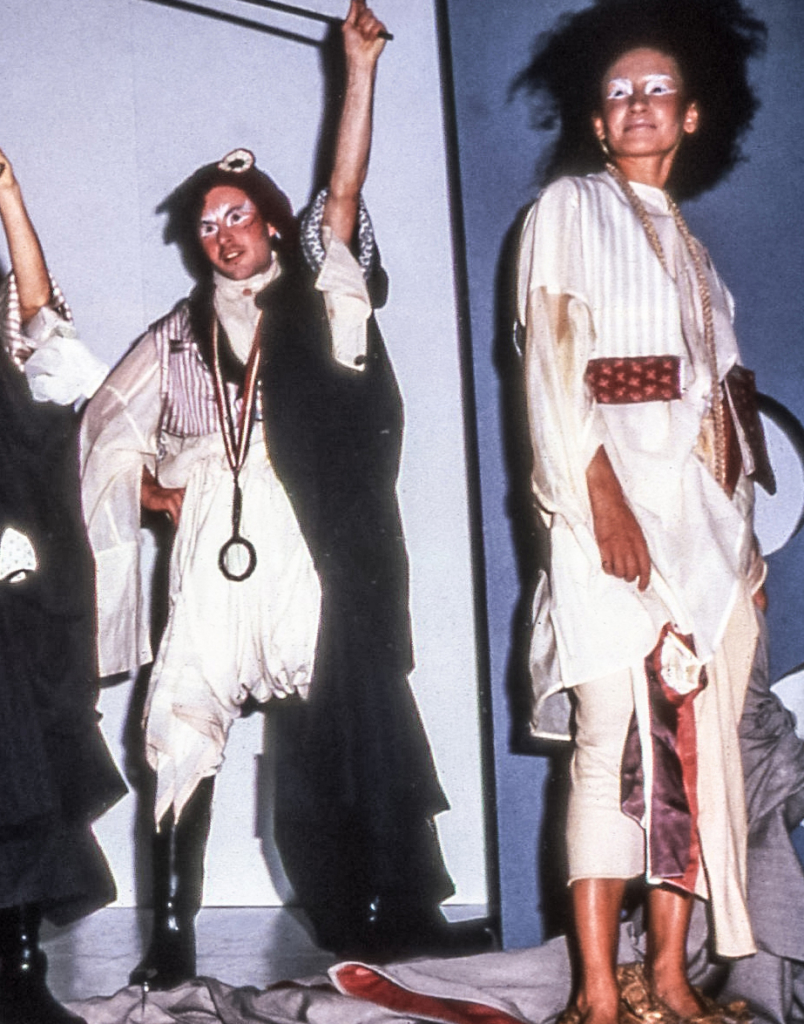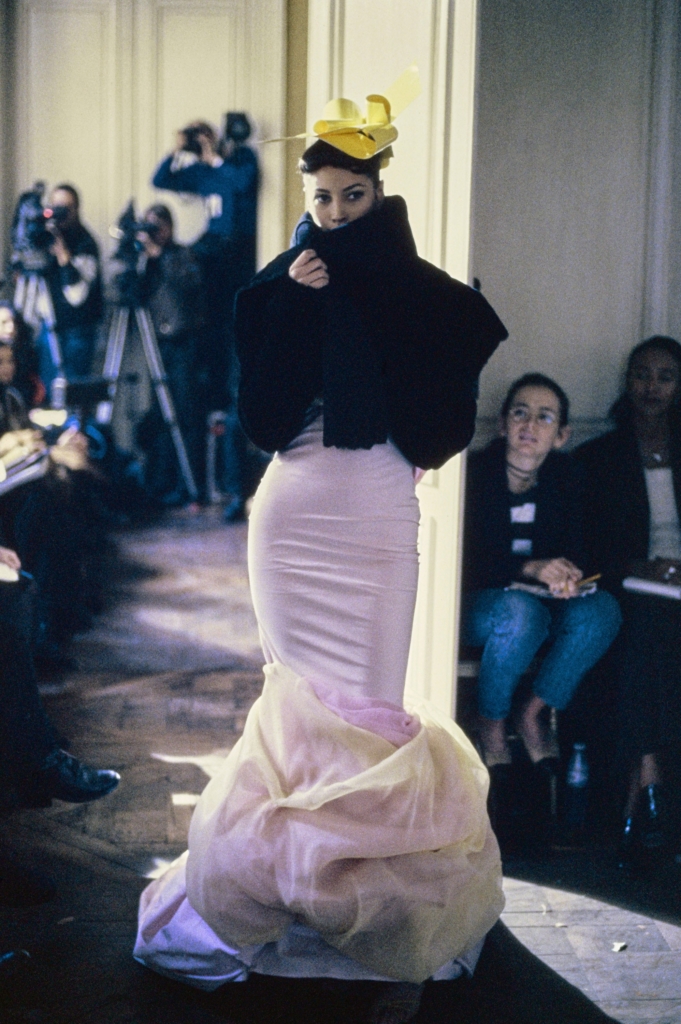Words Adrian Glass
Opening image: John Galliano Fall 1994 Ready to Wear Collection. Model Kate Moss
John Galliano’s rise to fame, from its early beginnings in London of the early 1980s to when he first moved to Paris in 1990, showcased himself as an inspiring British designer who not only could create a distinct take on the avant-garde, but was able to rework the finery of couture. Within his visionary styles of inversion and reformation that is traditional fashion. Intently studying the couturier masters of yesteryear, whilst at the same time immersed within the street styles of 80’s and 90’s London night club scenes. Galliano held an instinctive skill of stripping back fashion as a process of stylisation, to which he was able to engineer into his own concept of aesthetics.

John Galliano by Paolo Roversi 
John Galliano
Born in Gibraltar in 1960 to a Gibraltarian father Juan Galliano and a Spanish mother Anita Guillén, the family, including his two sisters, moved to England in 1966 settling in Dulwich, south of London. Both his parents being staunch Roman Catholics, sent a young John Galliano to be educated in his final years of schooling at Wilson’s Grammar School. His mother a Flamenco dancer always dressed an adolescent Galliano in her neatly styled ensembles. It was this flamboyancy of his mother’s creativity, rather than Galliano’s father who was a plumber, which had an impact on him at an earlier age. His interest in fashion lead him to study at the famous Saint Martin’s School of Art, graduating in 1984 with an honours degree of Fashion Design as his forte. The Saint Martin’s graduation show is where Galliano revealed his Les Incroyables collection, which three decades later, one can see his maintained interest in reshaping traditional attire, not in some do-it-yourself stylisation akin to fellow UK designer Vivienne Westwood’s earlier pieces, but rather to restructure clothing into a more abstracted and surreal way, yet at the same time offering a rebellious and cheeky concept. Inspired by the French revolution, Galliano’s first runway collection held true to its intention of the deconstruction and rebuilding of styles past and present.

John Galliano Les Incroyables, London, 1984 
John Galliano Les Incroyables, London, 1984 
John Galliano Les Incroyables, London, 1984
In the years that followed after Galliano’s debut Les Incroyables collection, he was able, on a limited budget with his dedicated creative team in tow, to design a slew of follow up collections after his graduation showing in 1984. In an attempt at drawing financial backers Galliano produced a further six collections, the first being the 1985 Fall/Winter array for London Fashion Week titled the The Ludic Game, which embellished an even more intensely take on the modernisation and remoulding of traditional garments. When looking back at his initial struggle as a young and poor fashion designer, there was a stalwart dedication to not down play the importance of fits in configuring Galliano’s precision of the envisioned styles he created. Without compromising the standard of his template. However, Galliano was unable to secure adequate funding for his later collections. He decided to move from London to Paris in 1990, struggling once again to source a financial backer, it was in 1993, after missing the October Fashion Week showing of the same year, Galliano, without any substantial monetary assistance, was able to stage an impressive showing for his 1994 Spring/Summer collection. He created, in his very skilled and precise way, a romanticised and fictional story of Princess Lucretia’s escape from her Russian nobility. Orchestrated with models dressed in couture inspired outfits, as they frantically ran down the runway. This was the beginning of Galliano’s fascination with rushed aesthetics.

John Galliano, Fall 1985 collection ‘The Ludic Game’ 
John Galliano, Fall 1985 collection ‘The Ludic Game’ 
John Galliano, Fall 1985 collection ‘The Ludic Game’
Photograph Eddy Kohli
Yet, his financial woes continued, as a relatively unknown UK designer sleeping on the floor of his friend’s apartment in Paris. It was American Vogue editor-in-chief Anna Wintour who became aware of Galliano’s plight and more importantly she witnessed his ‘Princess Lucretia’ show. Wintour allowed Galliano to have a large editorial for the Lucretia collection, which was seen in the March 1994 issue of Vogue. She also flew him to New York, setting up meetings with New York’s wealthy, as he began to gather clientèle for his couture styles. And it was also Wintour, through her financial contacts, that Galliano received $50,000 from the investment bank Paine Webber to assist in producing his future collections. But, it was the renown journalist and fashion power broker André Leon Talley, with his plethora of connections within the fashion industry, who introduced Galliano to the socialite, São Schlumberger, wife of Pierre Schlumberger, a billionaire oil magnate from French aristocracy. To which Galliano was given the use of São’s 17th Century and slightly run down Parisian Hôtel Particulier to host his up coming collection. Upon receiving these beneficial aspects, he returned back to Paris, quickly beginning work on what was considered a defining moment of his career, the 1994 Autumn/Winter collection held at the São’s mansion in Paris. This was Galliano’s couture imprint, not only showing his ability to restructure fashion under his creative mindset, he also promoted, in a very respectful nod, the couture masters of bygone eras. Galliano’s 94′ A/W collection was staged within São’s intimate salon setting, utilising only specific rooms of the 17th Century townhouse. Ensuring the most important aspect of the Paris Hôtel Particulier showing was its marketability, it was by far the most commercial to date for Galliano, essentially leaping him into the more corporate aspects of the fashion industry. In 1995 president of the French conglomerate LVMH Moët Hennessey, Bernard Arnault, promptly appointed Galliano to head the creative design for Givenchy. With Galliano presenting his first couture show for Givenchy in January 1996, however his time at the famed fashion house was short lived, with another UK designer gaining prominence within the fashion world; Alexander McQueen, who ended up replacing Galliano after just after one season. LVMH, aware of Galliano’s talent, transferred him over to Christan Dior, to which he maintained the helm as head designer from 1996 to 2010. At that time not only did Galliano achieve notable éclat for his Haute Couture ballroom gowns, Dior allowed Galliano to create his own signature range, also showcasing a series of commercially appealing Ready-to-Wear collections within the fifteen years of designing under the Dior banner.

John Galliano Fall 1994 Ready to Wear Collection. Model Nadja Auermann 
John Galliano Fall 1994 Ready to Wear Collection. Model Christy Turlington
In such a prolific rise to fame, Galliano’s downfall was equally as significant. On the 25th of February 2011, nearly sixteen years with Dior as their creative director, at a Paris bar, Galliano was arrested after his now infamous outburst, to which it was disclosed by the designer in the court case that followed, of an alcohol and drug fuelled tirade against Jews. The consequences from Galliano’s fall from grace was momentous, he was immediately asked to step down as creative director for Dior, as antisemitism is considered a criminal act in France, with French authorities charging Galliano for racist and antisemitic remarks. But it was the continued damage to his profile and fame as a designer which took its toll, if one is to look at the beginnings of Galliano’s rise from a financially poor London fashion designer in the 1990s, to his ascension into the fashion world in the early part of 2000. It was, in lieu of Galliano’s talented attributes, the powerful voices in fashion that may have also been let down by his misaligned outburst, as they, in the early part of his career, were the ones who had vouched for him, namely Anna Wintour. Galliano’s decline was not just attributed to him losing his reputation within the fashion industry, but also the confidence others had in him. Further blows occurred in 2013, when he lost all licensing to his namesake branding for Dior’s couture collections, with several legal battles occurring in the two years after the incident. Galliano was essentially sacked from his own brand name which was owned by the LVMH group.
However, it was Anna Wintour who once again offered Galliano a career lifeline, she negotiated for him to return back to the industry as a backstage advisor for the Couturier Master Oscar de la Renta and it was that same year, in 2013, with multiple court hearings between Galliano and Dior, that Galliano’s assistance to the late De la Renta shone through. Wintour, who had always been aware of Galliano’s intrinsic understanding of couture, ensured that Oscar de la Renta’s final show, before he passed away, would be an overall success. Galliano, on the 12th of June 2013, gave his first television interview for an America news network after being dismissed from Dior. In receiving a letter of absolution from the Anti-Defamation League, he asked “...I hope through my atonement, I’ll be given a second chance.” And in October 2014 that second chance was granted, when the parent company Only The Brave, that owns Maison Margiela stated that John Galliano would be the brand’s new creative director.

Oscar de la Renta Fall 2013. Model Kati Nescher 
Oscar de la Renta Fall 2013. Model Cara Delevingne 
Oscar de la Renta Fall 2013. Model Melissa Tammerijn 
Oscar de la Renta Fall 2013. Model Sigrid Agren
On January the 12th 2015 at London Fashion Week, Galliano returned as a vindicated fashion designer. More so was his absolve in showing what a skilled couturier he is, naming his first collection for Masion Margiela as the “Artisanal”. Thus setting the stage for his comeback, he also paid a respect to his roots, London. And in doing so, Galliano has been able to renew, but not relive, his time once again.

Maison Margiela Fall 2015 Couture Collection. Model Maartje Verhoef 
Maison Margiela Fall 2015 Couture Collection. Model Madison Stubbington 
Maison Margiela Fall 2015 Couture Collection. Model Carolin Loosen 
Maison Margiela Fall 2015 Couture Collection. Model Magdalena Jasek

